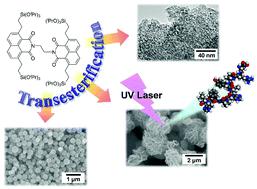当前位置:
X-MOL 学术
›
Mater. Chem. Front.
›
论文详情
Our official English website, www.x-mol.net, welcomes your
feedback! (Note: you will need to create a separate account there.)
Nanostructured organosilicas constructed by homopolycondensation of a transesterified bulky precursor and their potential in laser desorption/ionization
Materials Chemistry Frontiers ( IF 6.0 ) Pub Date : 2020-11-13 , DOI: 10.1039/d0qm00667j Norihiro Mizoshita 1, 2, 3 , Masakazu Murase 1, 2, 3 , Yuri Yamada 1, 2, 3 , Yasutomo Goto 1, 2, 3
Materials Chemistry Frontiers ( IF 6.0 ) Pub Date : 2020-11-13 , DOI: 10.1039/d0qm00667j Norihiro Mizoshita 1, 2, 3 , Masakazu Murase 1, 2, 3 , Yuri Yamada 1, 2, 3 , Yasutomo Goto 1, 2, 3
Affiliation

|
Covalently crosslinked organosilicas are useful for constructing optically, electronically and photochemically functional materials because of their robustness, morphological variety and tunability of the framework functionality based on the molecular design of the organic moieties. However, it has been challenging to prepare nanostructured organosilicas from 100% organosilane precursors with large organic functional moieties. In the present study, the synthesis of three types of nanostructured naphthalimide (NI)–silica hybrid materials has been achieved by hydrolysis and polycondensation of a common organosilane precursor and their photofunctional properties have been examined. The original NI-derived precursor having triisopropoxysilyl groups is highly hydrophobic and unsuitable for the preparation of nanostructured materials in aqueous media. Transesterification of the triisopropoxysilyl groups with 2-methoxyethanol or diethylene glycol monomethyl ether drastically changes the dispersibility and solubility of the NI-derived precursor in water, which enables the generation of nanospheres, microparticles with a wrinkled surface and periodic mesoporous organosilicas from the bulky NI derivative alone. The NI–silica hybrid particles that can efficiently absorb UV light can function as analytical substrates for laser desorption/ionization mass spectrometry (LDI-MS). The nanostructures of the NI–silica particles have significant effects on the LDI performance and their structure–property relationships are discussed.
中文翻译:

通过酯交换的大体积前体的均聚反应构建的纳米结构有机硅及其在激光解吸/电离中的潜力
共价交联的有机硅因其坚固性,形态学多样性以及基于有机部分分子设计的骨架功能的可调性,可用于构建光学,电子和光化学功能材料。然而,从具有大的有机官能部分的100%有机硅烷前体制备纳米结构的有机二氧化硅一直是挑战性的。在本研究中,通过常见有机硅烷前体的水解和缩聚反应,已经完成了三种类型的纳米结构萘二甲酰亚胺(NI)-二氧化硅杂化材料的合成,并对其光功能进行了研究。具有三异丙氧基甲硅烷基的原始NI衍生的前体是高度疏水的,并且不适合在水性介质中制备纳米结构材料。三异丙氧基甲硅烷基与2-甲氧基乙醇或二甘醇单甲醚的酯交换反应极大地改变了NI衍生的前体在水中的分散性和溶解性,从而能够从庞大的NI衍生物生成纳米球,表面起皱的微粒和周期性的介孔有机硅单独。可以有效吸收紫外线的NI-二氧化硅杂化颗粒可以用作激光解吸/电离质谱(LDI-MS)的分析底物。NI-二氧化硅颗粒的纳米结构对LDI性能有重要影响,并讨论了它们的结构-性质关系。
更新日期:2020-12-10
中文翻译:

通过酯交换的大体积前体的均聚反应构建的纳米结构有机硅及其在激光解吸/电离中的潜力
共价交联的有机硅因其坚固性,形态学多样性以及基于有机部分分子设计的骨架功能的可调性,可用于构建光学,电子和光化学功能材料。然而,从具有大的有机官能部分的100%有机硅烷前体制备纳米结构的有机二氧化硅一直是挑战性的。在本研究中,通过常见有机硅烷前体的水解和缩聚反应,已经完成了三种类型的纳米结构萘二甲酰亚胺(NI)-二氧化硅杂化材料的合成,并对其光功能进行了研究。具有三异丙氧基甲硅烷基的原始NI衍生的前体是高度疏水的,并且不适合在水性介质中制备纳米结构材料。三异丙氧基甲硅烷基与2-甲氧基乙醇或二甘醇单甲醚的酯交换反应极大地改变了NI衍生的前体在水中的分散性和溶解性,从而能够从庞大的NI衍生物生成纳米球,表面起皱的微粒和周期性的介孔有机硅单独。可以有效吸收紫外线的NI-二氧化硅杂化颗粒可以用作激光解吸/电离质谱(LDI-MS)的分析底物。NI-二氧化硅颗粒的纳米结构对LDI性能有重要影响,并讨论了它们的结构-性质关系。











































 京公网安备 11010802027423号
京公网安备 11010802027423号